What is happening?
- The United Nations estimates that at least half of all languages, mainly those spoken by Indigenous people, are in danger of extinction by 2100 (map below). Even more alarmingly, some studies have estimated that every two weeks, another language is lost.
- The loss of Indigenous languages is not just the loss of spoken practice. Indigenous languages also reflect the cultural heritage and practices of Indigenous communities. Most of Indigenous history is passed down orally and generations of Indigenous knowledge is preserved by modern speakers. As a result, the disappearance of Indigenous languages has a negative impact on the traditions and cultural identities of communities.
- Today, climate change and other environmental catastrophes pose a major threat to Indigenous communities and their languages. Across the world, Indigenous people are disproportionately impacted by natural disasters physically, economically, and spiritually.
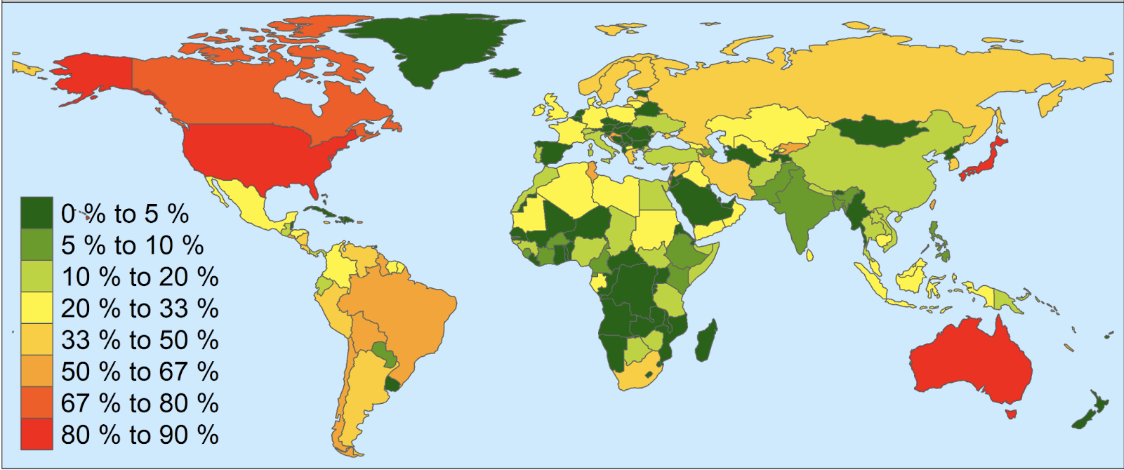
A global map of the percentage of Indigenous languages predicted to be extinct by 2093. According to the Ethnologue Expanded Graded Intergenerational Disruption Scale (EGIDS), a language is classified as extinct when it is no longer in use and is disassociated from any ethnic identity. This map highlights critical levels of Indigenous language loss in North America, South America, and Australia (from Simons, 2019).
Colonization and Indigenous Languages
- Since the 15th century, European colonizers have oppressed Indigenous peoples across the world. Through their acquisition of land, colonists deprived Indigenous communities of their homes and damaged their culture and livelihoods.
- Historically, some governments have intentionally put laws into place discriminating against Indigenous peoples and creating barriers to the survival of their languages. For example, Canada, the U.S., and Australia all implemented government policies supporting the systematic removal of Indigenous children from their homes in an active effort to assimilate Indigenous children with the predominant national culture. From the 1830s to the 1990s, the Canadian government oppressed Indigenous people by forcing children to attend residential schools and be separated from their families to suppress Indigenous customs. The U.S. did the same between 1819 and 1969 (image below), as did Australia from 1910 to 1970.
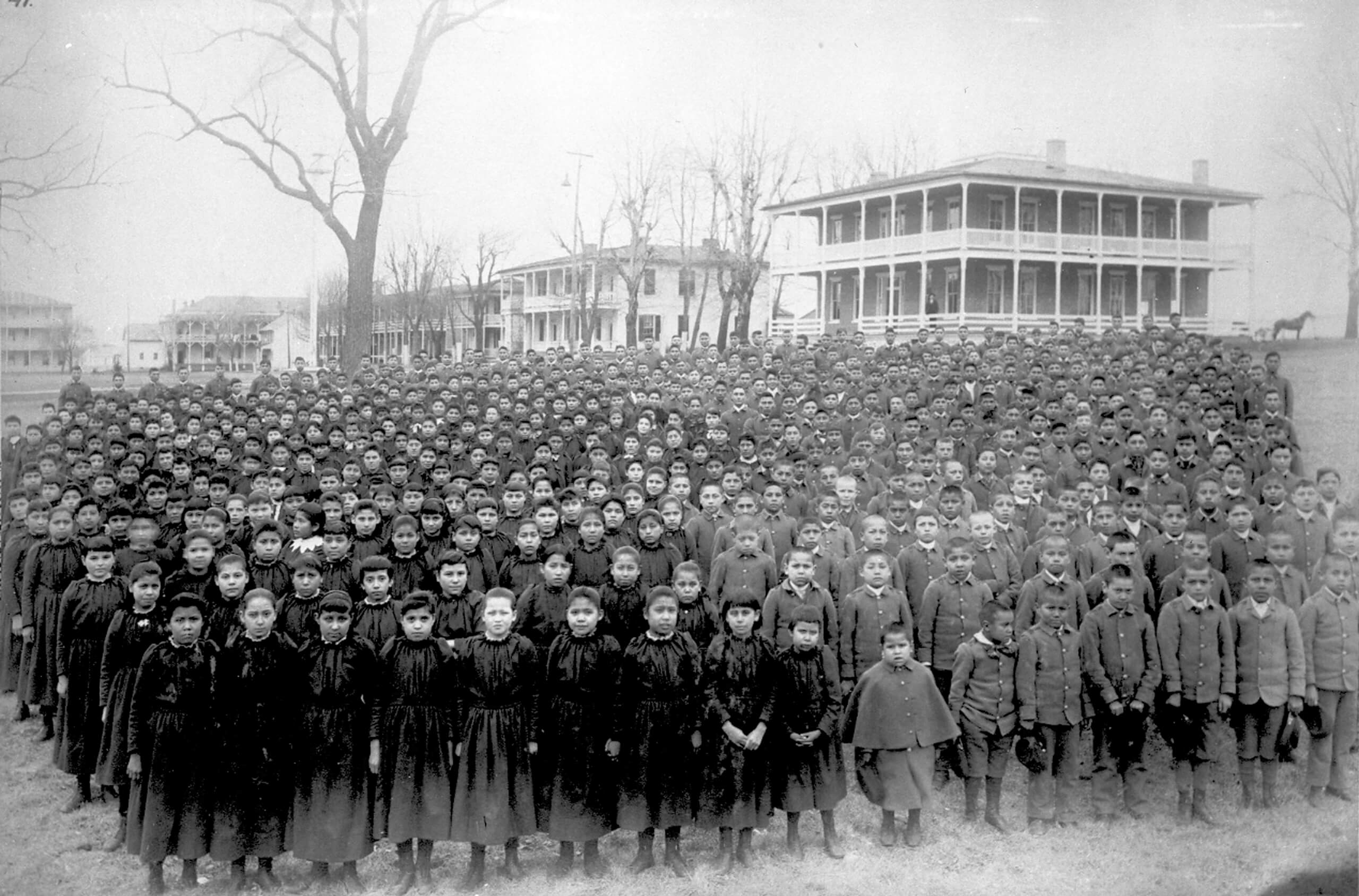
Photograph of hundreds of children at the Carlisle Indian Industrial School, taken in Carlisle, Pennsylvania in March 1892 (from National Museum of the American Indian Smithsonian, 2020). The Carlisle Indian Industrial School operated for thirty years with the goal of assimilating Indigenous children forcibly stolen from their families and lives across the U.S.
-
-
- Colonial powers have also oppressed Indigenous peoples through outright violence and warfare. The U.S.-Dakota War of 1862 is one such example. This conflict was initiated by settlers from the state of Minnesota with the intention of forcibly removing the Dakota people so that settlers could occupy their land. Following the month-long battle, 38 Dakota men were executed under U.S. federal law. Over 2,000 men, women, and children were held in the Fort Snelling Concentration Camp, hundreds of whom died due to poor conditions and disease. Congress then outlawed the Dakota people from living in Minnesota, and bounties were posted, rewarding settlers for killing Indigenous people.
-
- In addition to direct violence, European explorers and colonizers have further oppressed Indigenous communities with the introduction of foreign diseases. Because Indigenous people were never exposed to diseases like smallpox, influenza, measles, and pneumonia, to name a few, they lacked immunity and were more susceptible to severe illness and death. Christopher Columbus’ arrival in 1492 brought disease and death to the present-day islands of the Bahamas and Hispaniola, decimating the population of Indigenous Taino people. Since the mid-16th century, European traders flocked to New England, exposing groups of Indigenous peoples, such as the Wampanoag Nation (now recognized as the Mashpee Wampanoag Tribe and the Wampanoag Tribe of Gay Head (Aquinnah)), to various ailments. Recent research theorizes that one disease called leptospirosis, carried by rats transported on ships from Europe, killed an estimated 75% to 95% of the Indigenous population of the Americas. The massive loss of Indigenous lives due to the actions of European colonizers, has been named the ‘Great Dying’ (c. 1520-1700 CE) by Western scholars.
- The introduction of deadly diseases posed the greatest threat to Indigenous elders and children. The loss of elders with great knowledge of language and traditions, combined with the loss of children to pass it on to, endangers the survival of Indigenous languages.
- Colonialism has driven many Indigenous languages to extinction. In Australia, of the existing 200 to 300 aboriginal languages, only 60 are considered unthreatened. The Indigenous Language Institute estimates that over 300 Indigenous languages were spoken in the U.S. at the time of initial European settlement. As of 2022, only 175 are still spoken. Currently, a significant number of languages have few remaining speakers and are in danger of extinction (map above).
Climate Change Threatens Indigenous Livelihoods and Languages
- The rising threat of climate change has the potential to impact billions of people across the planet. However, Indigenous communities face additional challenges. Adverse conditions associated with experiencing and adapting to climate change exacerbate the traditional language loss brought on by settler colonialism. This in turn negatively impacts Indigenous people’s ability to survive in the rapidly changing landscape. Indigenous cultures and languages are inherently adaptive to change, but not of this destructive magnitude.
- According to the US Environmental Protection Agency (EPA), Indigenous people have a higher likelihood of developing chronic medical conditions. Past and present economic and political factors limit many Indigenous communities’ access to healthcare and wellness. For example, governments forcibly took Indigenous land and placed Indigenous peoples in reservations, disrupting their traditional agricultural and hunting practices. Unable to grow or hunt traditional foods, they were limited to innutritious government rations, contributing to overall health declines. Furthermore, the trauma of historic colonization continues to impact the physical, emotional, and mental health of Indigenous peoples. As air quality and pollution worsen with climate change, health risks are on the rise.
- The protection of Indigenous land is essential to the preservation and continuation of traditional Indigenous livelihoods (image below). Political and institutional regulations of Indigenous land can restrict livelihoods, and in some scenarios, limit how communities can respond to climate threats.
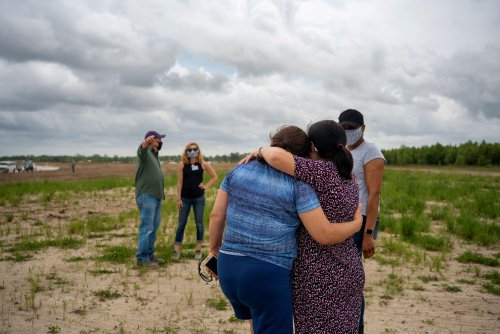
Photograph of people from the Biloxi-Chitimacha-Choctaw Tribe in 2021, visiting a resettlement site further inland from the Isle de Jean Charles (Louisiana, U.S.) where they resided. Ninety-eight percent of this island located in the Mississippi River Delta has flooded due to sea level rise. This environmental change greatly disrupted livelihoods, communities, and culture, forcing members of the Biloxi-Chitimacha-Choctaw Tribe to relocate (from Environmental Protection Agency, 2022).
-
- Most rural and traditional Indigenous communities do not have access to reliable infrastructure. The infrastructure gap in developed nations is largely the result of inequitable government investment distribution, which often excludes Indigenous groups. Many Indigenous communities face deficits in housing, water treatment, transportation, energy, and internet services. This limits the amount and quality of resources available and makes climate change adaptation more difficult.
- As a result of decisions by settler governments, dispersed geographic locations, increased pollution, and other reasons, many Indigenous communities lack access to clean drinking water. This resource is becoming increasingly scarce with ongoing climate change. Some Indigenous communities do not have modern water purification infrastructure, especially in isolated locations. Unsafe drinking water has already caused outbreaks of water-borne illnesses in reservations like Fort Apache in Arizona, U.S. The EPA reported that algal blooms and bacterial growths are becoming more common with rising water temperatures. Furthermore, climate change is responsible for irregular precipitation patterns and coastal flooding due to melting sea ice. Sea level rise has also been associated with saltwater intrusions into coastal freshwater aquifers, which are natural groundwater reservoirs. Small islands, many of which are home to Indigenous communities, are especially vulnerable to saltwater intrusion and contamination of freshwater sources through mixing with seawater.
- Due to continuing global warming and climate change droughts have become an increasingly common phenomenon. Longer periods of minimal rainfall have forced Indigenous communities like the Maasai in Kenya, Africa, to give up their traditional livelihoods in favor of commercialized agriculture and other market ventures. For centuries the Maasai people have herded livestock in African grasslands. However, climate change-induced drought has made the practice unsustainable as land fertility decreases (image below). Consequently, Maasai people have been assimilating with non-Indigenous Kenyan and Tanzanian cultures. This poses a threat to the future of Maasai culture and language. Currently, half a million people speak Maa, the language of the Maasai people, but if cultural assimilation continues and Maasai traditions are abandoned, this number will likely continue to drop.
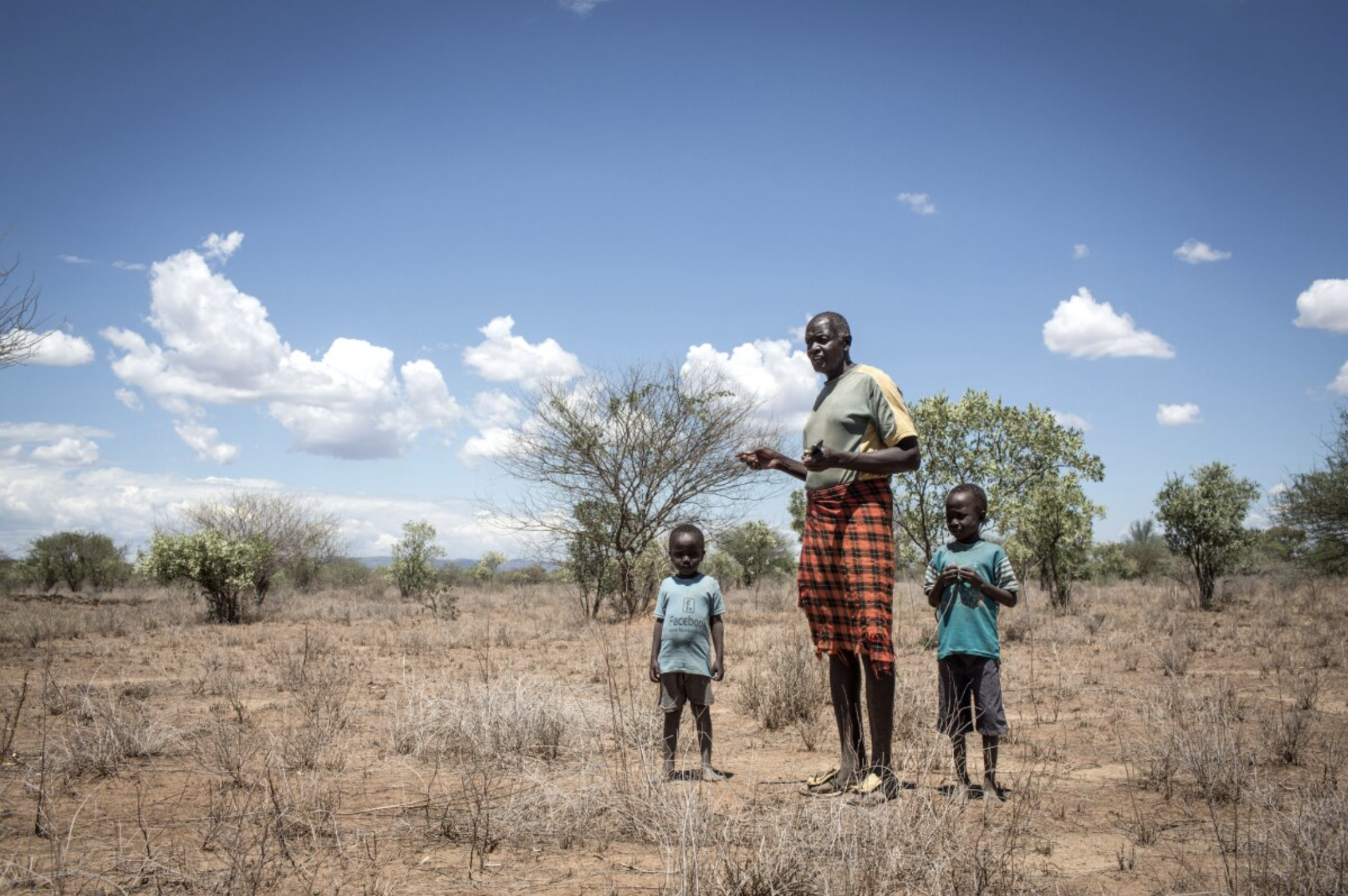
Effect of drought in central Kenya resulting in a massive loss of plant life (from Langat, 2017). Once bountiful grasslands can no longer sustain grazing livestock and the lifestyle of Maasai herders.
- Climbing Arctic temperatures are threatening the practices of Inuit communities in Northern Canada, Alaska, and Greenland. Inuit people rely on intact ice sheets and sea ice for their survival. Hunters kill caribou and seals that rely on a stable environment and sea ice habitat. Climate change has rapidly affected the Arctic climate, causing warmer conditions and resulting in rapid sea ice loss (image below). Without a stable environment, many Inuit, like the Maasai, are forced to relocate with threat to their cultural ways. When Indigenous people assimilate with other cultures or countries, Indigenous languages are often abandoned.
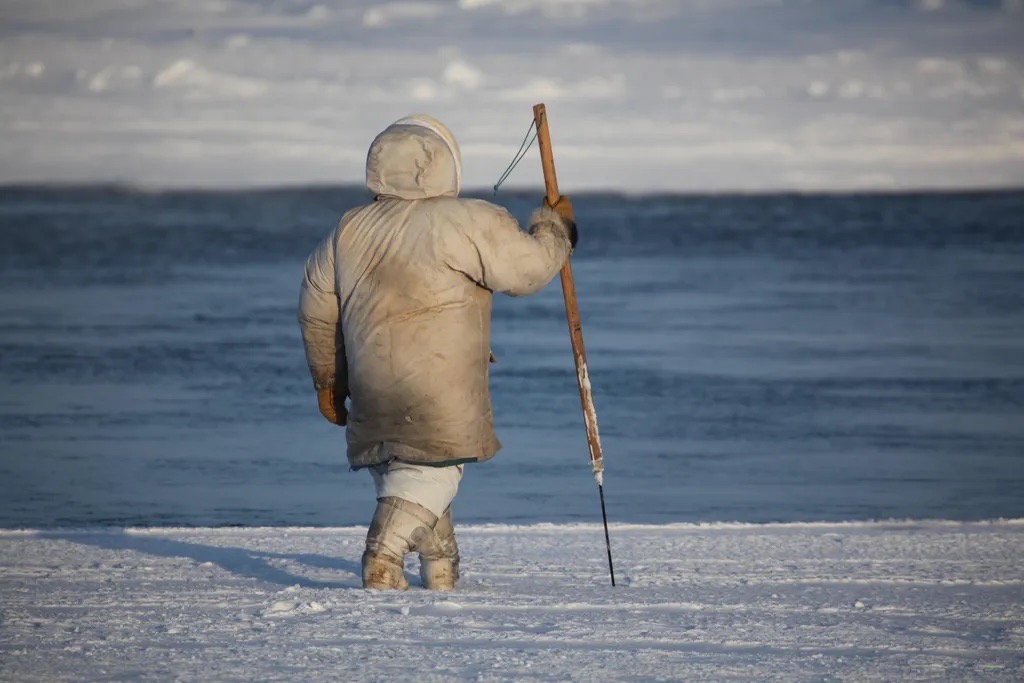
Inuit hunter faced with melting sea ice (from NyDailyNews, 2019). Rapid sea ice loss and changing terrain have made hunting increasingly difficult, threatening the livelihood of Inuit communities who rely on caribou and seals as a major food source.
- Similarly, climate change is affecting the Iñupiat people of Northern Alaska. The Iñupiaq language has specialized vocabulary and grammatical structures that allow for efficient and effective communication about polar environmental conditions. However, the melting sea ice and thawing permafrost have threatened local fisheries and infrastructure. Iñupiaq is a very embodied language, so the best setting for learning is intergenerational group activities such as hunting, harvesting, preparation, and consumption of traditional foods. With rising temperatures, animal migration patterns are changing and spring hunting seasons become shorter, reducing the window of opportunity for language learning.
References and additional resources
- Black, K. “Indigenous communities should dictate how $1 billion infrastructure investment is spent.” The Conversation. 2021. https://theconversation.com/Indigenous-communities-should-dictate-how-1-billion-infrastructure-investment-is-spent-158027.
- Braine, T. “Inuit hunters navigating climate-change-induced ice loss now have an app for that – and more.” New York Daily News. 2019. https://www.nydailynews.com/news/world/ny-inuit-siku-app-Hunting-ice-melt-hunters-arctic-20191211-ojppcn2jafc4ff3st3j7k22tya-story.html.
- Cecco, L. “Dozens of Canada’s First Nations lack drinking water: ‘Unacceptable in a country so rich.” The Guardian. 2021. https://www.theguardian.com/world/2021/apr/30/canada-first-nations-justin-trudeau-drinking-water.
- Clark, A. “Words of Wisdom.” Global Climate Pledge. 2022. https://www.globalclimatepledge.com/Words-of-wisdom-the-Indigenous-languages-that-are-threatened-by-climate-change-can-also-be-used-to-stop-it.
- “Collection Gallery.” National Museum of the American Indian Smithsonian. 2020. https://americanindian.si.edu/nk360/code-talkers/collection-gallery/.
- Davis, W. “Why Indigenous Languages Matter.” Canadian Geographic. 2019. https://canadiangeographic.ca/articles/why-Indigenous-languages-matter/.
- “Effects of Climate Change on Indigenous Languages.” Indigenous Climate Hub. 2018. https://Indigenousclimatehub.ca/the-effect-of-climate-change-on-Indigenous-languages/.
- Environmental Protection Agency. “Climate Change and the Health of Indigenous Populations.” EPA. 2022. https://www.epa.gov/climate-change/climate-change-and-health-Indigenous-populations#key.
- Guha, A. “Family Separation Is a US Tradition. Just Ask Native Communities.” Better Care Network. 2018. https://bettercarenetwork.org/news-updates/news/family-separation-is-a-us-tradition-just-ask-native-communities.
- Korff, J. “Loss of Aboriginal Languages.” Creative Spirits. 2020, https://www.creativespirits.info/aboriginalculture/language/loss-of-aboriginal-languages#why-did-we-lose-so-many-aboriginal-languages.
- Korff, J. “A guide to Australia’s Stolen Generations.” Creative Spirits. 2022, https://www.creativespirits.info/aboriginalculture/politics/stolen-generations/a-guide-to-australias-stolen-generations.
- Laduzinsky, P. “The Disproportionate Impact of Climate Change on Indigenous Communities.” KCET. 2019. https://www.kcet.org/shows/tending-nature/the-disproportionate-impact-of-climate-change-on-Indigenous-communities.
- Luu, C. “How Language and Climate Connect.” JSTOR Daily. 2019. https://daily.jstor.org/how–language-and-climate-connect/.
- Olson, R. “Native American Language Loss.” EcoVentures English. 2022. https://www.ecoventuresenglish.com/post/native-american-language-loss.
- Patagonia, “Newtok |The Water is Rising.” Youtube. 2022. https://www.youtube.com/watch?v=_QNYQfdVEOk.
- Reséndez, A. The Other Slavery: The Uncovered Story of Indian Enslavement in America. Houghton Mifflin Harcourt. 2016.
- Riehl, A. “The Impact of Climate Change on Language Loss.” The Conversation. 2022. https://theconversation.com/the-impact-of-climate-change-on-language-loss-105475.
- Simons, G. F. “Two centuries of spreading language loss.” Linguistic Society of America. 2019. https://journals.linguisticsociety.org/proceedings/index.php/PLSA/article/view/4532.
- “Surviving New England’s Great Dying.” NH PBS. 2021. https://nhpbs.org/greatdying/.
- “Timeline – Native Voices.” U.S. National Library of Medicine. https://www.nlm.nih.gov/nativevoices/timeline/index.html.
- Toth, K. “The Death and Revival of Indigenous Languages.” Harvard International Review. 2022. https://hir.harvard.edu/the-death-and-revival-of-Indigenous-languages/.
- UN Department of Public Information. “The United Nations Permanent Forum on Indigenous Issues.” United Nations. https://www.un.org/development/desa/Indigenouspeoples/wp-content/uploads/sites/19/2018/04/Indigenous-Languages.pdf.
- “US-Dakota War of 1862.” University of Minnesota: College of Liberal Arts: Holocaust and Genocide Studies. https://cla.umn.edu/chgs/holocaust-genocide-education/resource-guides/us-dakota-war-1862.
- Vocativ. “UNESCO: Half of All Languages Will Be Extinct within 100 Years.” Business Insider. Business Insider. https://www.businessinsider.com/unesco-half-of-all-languages-extinct-within-100-years-2015-4.
